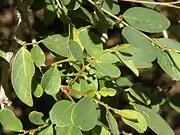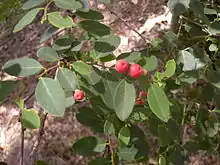Breynia oblongifolia
Breynia oblongifolia, commonly known as coffee bush, grows naturally in Australia and New Guinea as shrubs up to 3 m (10 ft) in height. The species produces alternate, ovate leaves 20–30 mm (0.8–1.2 in) long. Small, green flowers are produced in spring and summer, and these are followed by orange or pink berries about 6 mm (0.24 in) diameter that turn black when fully ripe.

| Breynia oblongifolia | |
|---|---|
 | |
| Breynia oblongifolia fruit and foliage | |
| Scientific classification | |
| Kingdom: | Plantae |
| Clade: | Tracheophytes |
| Clade: | Angiosperms |
| Clade: | Eudicots |
| Clade: | Rosids |
| Order: | Malpighiales |
| Family: | Phyllanthaceae |
| Genus: | Breynia |
| Species: | B. oblongifolia |
| Binomial name | |
| Breynia oblongifolia | |
The species tolerates wide variety of environments, and is found in coastal tropical rainforests in North Queensland and New Guinea through to cool Eucalypt woodlands in south–eastern New South Wales to arid Acacia woodlands in Western Queensland. This plant proliferates in disturbed areas and can recolonise cleared sites and can pop up occasionally in undisturbed gardens, the species will spread at the expense of fire-dependent species if fire is withdrawn from an ecosystem used to being burnt. This plant supports many different animals that feed on leaves, berries and flowers.
This native shrub may be confused with Senna species which are found in similar habitats, but Senna has opposite leaves (leaflets facing each other in pairs) unlike the alternate leaves of B. oblongifolia, and Senna produces conspicuous yellow flowers followed by leguminous pods in contrast to the inconspicuous flowers and red berries of B. oblongifolia.
Breynia oblongifolia presumably is dependent on leafflower moths (Epicephala spp.) for its pollination, like other species of tree in the genus Breynia.[2][3] Leafflower moths have been reared from fruit of this species in Australia.[4]
References
- "Breynia oblongifolia". Australian Plant Name Index (APNI), IBIS database. Centre for Plant Biodiversity Research, Australian Government, Canberra. Retrieved 10 October 2008.
- Kawakita, A.; Kato, M. 2004. Obligate pollination mutualism in Breynia (Phyllanthaceae): further documentation of pollination mutualism involving Epicephala moths (Gracillariidae). American Journal of Botany. 91: 1319–1325
- Zhang, J.; Wang, S.; Li, H.; Hu, B.; Yang, X.; Wang, Z. 2012. "Diffuse coevolution between two Epicephala species (Gracillariidae) and two Breynia species (Phyllanthaceae). PLOS ONE. 7: e41657.
- Kawakita, A.; Kato, M. 2009. "Repeated independent evolution of obligate pollination mutualism in the Phyllantheae-Epicephala association." Proceedings of the Royal Society B. 276: 417–426.
- Hyland, B. P. M.; Whiffin, T.; Zich, F. A.; et al. (December 2010). "Factsheet – Breynia oblongifolia". Australian Tropical Rainforest Plants (6.1, online version RFK 6.1 ed.). Cairns, Australia: Commonwealth Scientific and Industrial Research Organisation (CSIRO), through its Division of Plant Industry; the Centre for Australian National Biodiversity Research; the Australian Tropical Herbarium, James Cook University. Retrieved 23 June 2013.